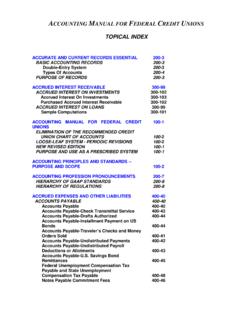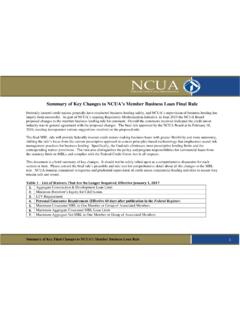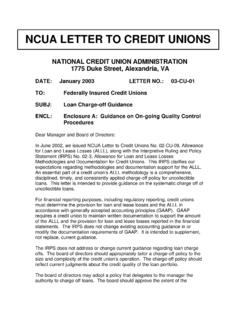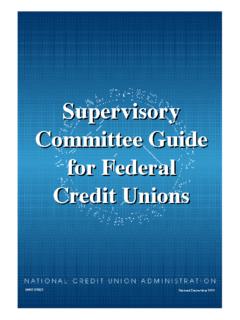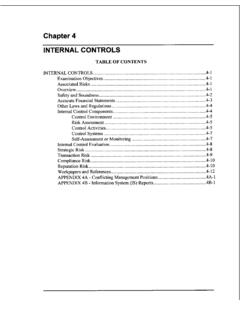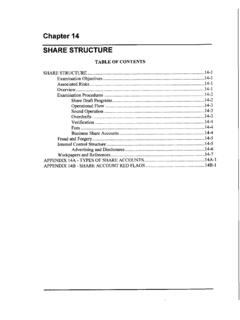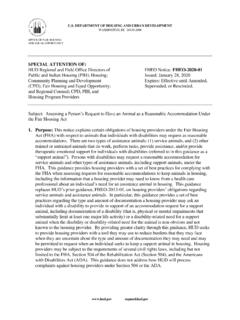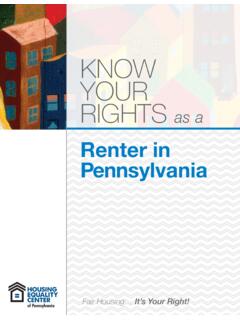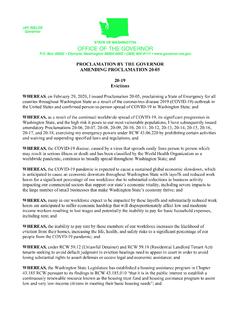Transcription of Office of Consumer Financial Protection Fair Lending Guide
1 Office of Consumer Financial Protection fair Lending Guide July 2017 National Credit Union Administration fair Lending Guide Table of Contents Using this Guide .. 2 Introduction .. 3 Equal Credit Opportunity Act (Regulation B) Overview .. 6 Operational Requirements .. 9 Review 12 Checklist .. 18 Definitions .. 24 fair housing Act Overview .. 29 Operational Requirements .. 32 Review 33 Checklist .. 37 Definitions .. 38 Home Mortgage Disclosure Act (Regulation C) Overview .. 40 Operational Requirements .. 43 Review 45 Checklist .. 48 Definitions .. 51 fair Lending Guide 2017 1 Office of Consumer Financial Protection National Credit Union Administration Using this Guide This Guide is intended for use by a credit union s board of directors and management, compliance officers, and others having responsibility for fair Lending compliance as part of their duties.
2 While the Guide covers federal fair Lending laws and regulations that affect federal credit unions, it does not address all federal Consumer Protection laws or any state laws. This fair Lending Guide is divided into five sections: Overviews provide a brief description of what is covered in each fair Lending law and regulation, what the regulations require of credit unions, and some potential risks. Operational requirements denote specific requirements covered in each fair Lending law and regulation and possible administrative actions for noncompliance. Review Considerations contain various areas management should consider when evaluating fair Lending compliance issues or developing compliance policies. Checklists can be used to test compliance with the various fair Lending laws and regulations, or as a starting point in developing a policy for compliance with the various regulations.
3 The questions are written so that a yes answer indicates compliance with the regulation, and a no answer indicates a potential problem area Definitions defines terms used in the narrative sections of this Guide as well as terms used in each fair Lending law and regulation. While the content of this Guide was carefully reviewed for applicability and accuracy, changes occur in the wording and interpretation of Consumer compliance regulations. If a situation arises where this Guide becomes inconsistent with the provisions of applicable laws or regulations, the requirement of the law or regulation will prevail. 2 Introduction Overview of fair Lending Laws and Regulations This overview provides a basic and abbreviated discussion of federal fair Lending laws and regulations.
4 It is adapted from the Interagency Policy Statement on fair Lending issued in March 1994. The Equal Credit Opportunity Act (ECOA) prohibits discrimination in any aspect of a credit transaction. It applies to any extension of credit, including extensions of credit to small businesses, corporations, partnerships, and trusts. The ECOA prohibits discrimination based on: Race or color Religion National origin Sex Marital status Age (provided the applicant has the capacity to contract) The applicant s receipt of income derived from any public assistance program The applicant s exercise, in good faith, of any right under the Consumer Credit Protection Act Regulation B, found at 12 CFR part 1002, implements the ECOA. Regulation B describes Lending acts and practices that are specifically prohibited, permitted, or required.
5 Official staff interpretations of the regulation are found in Supplement I to 12 CFR part 1002. The fair housing Act (FH Act) prohibits discrimination in all aspects of "residential real-estate related transactions," including but not limited to: Making loans to buy, build, repair or improve a dwelling Purchasing real estate loans Selling, brokering, or appraising residential real estate Selling or renting a dwelling The FH Act prohibits discrimination based on: Race or color National origin Religion fair Lending Guide 2017 3 Office of Consumer Financial Protection National Credit Union Administration Sex Familial status (defined as children under the age of 18 living with a parent or legal custodian, pregnant women, and people securing custody of children under 18) Handicap Department of housing and Urban Development (HUD) regulations implementing the FH Act are found at 24 CFR Part 100.
6 Because both the FH Act and the ECOA apply to mortgage Lending , lenders may not discriminate in mortgage Lending based on any of the prohibited factors in either list. Under the ECOA, it is unlawful for a lender to discriminate on a prohibited basis in any aspect of a credit transaction, and under both the ECOA and the FH Act, it is unlawful for a lender to discriminate on a prohibited basis in a residential real-estate-related transaction. Under one or both of these laws, a lender may not, because of a prohibited factor: Fail to provide information or services or provide different information or services regarding any aspect of the Lending process, including credit availability, application procedures, or Lending standards Discourage or selectively encourage applicants with respect to inquiries about or applications for credit Refuse to extend credit or use different standards in determining whether to extend credit Vary the terms of credit offered, including the amount, interest rate, duration, or type of loan Use different standards to evaluate collateral Treat a borrower differently in servicing a loan or invoking default remedies Use different standards for pooling or packaging a loan in the secondary market.
7 A lender may not express, orally or in writing, a preference based on prohibited factors or indicate that it will treat applicants differently on a prohibited basis. A violation may still exist even if a lender treated applicants equally. A lender may not discriminate on a prohibited basis because of the characteristics of: An applicant, prospective applicant, or borrower A person associated with an applicant, prospective applicant, or borrower (for example, a co-applicant, spouse, business partner, or live-in aide) The present or prospective occupants of either the property to be financed or the characteristics of the neighborhood or other area where property to be financed is located. 4 Finally, the FH Act requires lenders to make reasonable accommodations for a person with disabilities when such accommodations are necessary to afford the person an equal opportunity to apply for credit.
8 National Credit Union Administration (NCUA) enforcement of fair Lending Laws NCUA implemented its fair Lending examination program in 1999. With the exception of those federally insured credit unions with assets over $10 billion, which are under the authority of the Consumer Financial Protection Bureau, NCUA enforces ECOA and Regulation B in federal credit unions and the Home Mortgage Disclosure Act (HMDA) and Regulation C in all federally insured credit unions. ECOA requires NCUA to refer matters to the Department of Justice (DOJ) when NCUA has a reason to believe that a federal credit union has engaged in a pattern or practice of discrimination on a prohibited basis. NCUA s fair Lending examination program also assesses compliance with the FH Act, but HUD and DOJ enforce the FH Act. NCUA reports violations of the FH Act to HUD or DOJ.
9 NCUA conducts fair Lending examinations at and supervisory contacts with federal credit unions to assess compliance with fair Lending laws using the Federal Financial Institutions Examination Council (FFIEC) Interagency fair Lending Examination Procedures (August 2009). fair Lending Guide 2017 5 Office of Consumer Financial Protection National Credit Union Administration EQUAL CREDIT OPPORTUNITY ACT (REGULATION B) OVERVIEW The Equal Credit Opportunity Act (ECOA), implemented by Regulation B (12 CFR 1002), promotes availability of credit to all creditworthy applicants without regard to race, color, religion, national origin, sex, marital status, age (provided the applicant has the capacity to contract), receipt of public assistance, or good faith exercise of any rights under the Consumer Credit Protection Act.
10 The basic rule of Regulation B, as found in , is: "A creditor shall not discriminate against any applicant on a prohibited basis with respect to any aspect of a credit transaction." Prohibited basis refers not only to the characteristics of the applicant, but also to the characteristics of individuals with whom the applicant is affiliated or associates. Therefore, a credit union may not discriminate against a member-applicant based on a prohibited basis characteristic of an associated individual. For example, a credit union cannot discriminate against an applicant because of the race of the residents in the neighborhood where the collateral property is located. Credit transaction means every aspect of an applicant s dealings with a credit union regarding an application for credit or an existing extension of credit including, but not limited to, information requirements, investigation procedures, standards of creditworthiness, terms of credit, furnishing of credit information, revocation, alteration, or termination of credit, and collection procedures.
